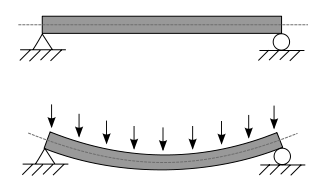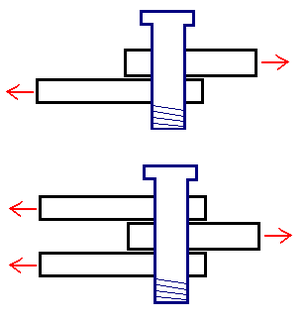Y
Yield strength – Young's modulus
| Look up engineering in Wiktionary, the free dictionary. |
| Wikiversity has learning resources about Engineering |
This is an alphabetical list of articles pertaining specifically to civil engineering. For a broad overview of engineering, please see List of engineering topics. For biographies please see List of civil engineers.
Accuracy and precision – American Society of Civil Engineers – Applied mechanics – Arch
Carbon fiber – Check dam – Classical mechanics – Composite material – Compressive strength – Computational fluid dynamics – Computer-aided design – Conservation of mass – Concrete – Corrosion
Dam – Damping ratio – Deformation – Delamination – Design – Dimensionless number – Drafting – Dynamics
Factor of safety – Fatigue – Fillet – Finite element analysis – Finite element method – Fluid mechanics – Force – Friction – Fundamentals of Engineering exam
Lever – Liability – Life cycle cost analysis – Limit state design – Load transfer
Margin of safety – Mass transfer – Materials – Materials engineering – Material selection – Mechanics – Moment – Moment of inertia
Physics – Plasticity – Plastic moment – Poisson's ratio – Position vector – Pressure – Product lifecycle management – Professional engineer – Project management – Pulley – Pump – Pile foundation
Quality – Quality control – Quantity surveying
Reliability engineering – Resistive force – Reverse engineering – Rigid body – Reinforced concrete –
Safety engineering – Shear force diagrams – Shear modulus – Shear strength – Shear stress – Simple machine – Simulation – Slide rule – Solid mechanics – Solid modeling – Spoolbase – Statics – Stress–strain curve – Structural failure – Student design competition – Surveying –
Technical drawing – Technology – Tensile strength – Tensile stress – Theodolite – Theory of elasticity – Toughness – Turbine –
Wedge – Weight transfer – Weir
Yield strength – Young's modulus
| Look up engineering in Wiktionary, the free dictionary. |
| Wikiversity has learning resources about Engineering |
Rheology is the study of the flow of matter, primarily in a liquid or gas state, but also as "soft solids" or solids under conditions in which they respond with plastic flow rather than deforming elastically in response to an applied force. Rheology is a branch of physics, and it is the science that deals with the deformation and flow of materials, both solids and liquids.

In continuum mechanics, stress is a physical quantity that expresses the internal forces that neighbouring particles of a continuous material exert on each other, while strain is the measure of the deformation of the material. For example, when a solid vertical bar is supporting an overhead weight, each particle in the bar pushes on the particles immediately below it. When a liquid is in a closed container under pressure, each particle gets pushed against by all the surrounding particles. The container walls and the pressure-inducing surface push against them in (Newtonian) reaction. These macroscopic forces are actually the net result of a very large number of intermolecular forces and collisions between the particles in those molecules. Stress is frequently represented by a lowercase Greek letter sigma (σ).
In physics and materials science, elasticity is the ability of a body to resist a distorting influence and to return to its original size and shape when that influence or force is removed. Solid objects will deform when adequate loads are applied to them; if the material is elastic, the object will return to its initial shape and size after removal. This is in contrast to plasticity, in which the object fails to do so and instead remains in its deformed state.
The field of strength of materials, also called mechanics of materials, typically refers to various methods of calculating the stresses and strains in structural members, such as beams, columns, and shafts. The methods employed to predict the response of a structure under loading and its susceptibility to various failure modes takes into account the properties of the materials such as its yield strength, ultimate strength, Young's modulus, and Poisson's ratio. In addition, the mechanical element's macroscopic properties such as its length, width, thickness, boundary constraints and abrupt changes in geometry such as holes are considered.
An elastic modulus is a quantity that measures an object or substance's resistance to being deformed elastically when a stress is applied to it. The elastic modulus of an object is defined as the slope of its stress–strain curve in the elastic deformation region: A stiffer material will have a higher elastic modulus. An elastic modulus has the form:

Shear stress, often denoted by τ, is the component of stress coplanar with a material cross section. It arises from the shear force, the component of force vector parallel to the material cross section. Normal stress, on the other hand, arises from the force vector component perpendicular to the material cross section on which it acts.
Solid mechanics, also known as mechanics of solids, is the branch of continuum mechanics that studies the behavior of solid materials, especially their motion and deformation under the action of forces, temperature changes, phase changes, and other external or internal agents.

Stiffness is the extent to which an object resists deformation in response to an applied force.
Stress–strain analysis is an engineering discipline that uses many methods to determine the stresses and strains in materials and structures subjected to forces. In continuum mechanics, stress is a physical quantity that expresses the internal forces that neighboring particles of a continuous material exert on each other, while strain is the measure of the deformation of the material.

A beam is a structural element that primarily resists loads applied laterally to the beam's axis. Its mode of deflection is primarily by bending. The loads applied to the beam result in reaction forces at the beam's support points. The total effect of all the forces acting on the beam is to produce shear forces and bending moments within the beams, that in turn induce internal stresses, strains and deflections of the beam. Beams are characterized by their manner of support, profile, equilibrium conditions, length, and their material.
This is an alphabetical list of articles pertaining specifically to mechanical engineering. For a broad overview of engineering, please see List of engineering topics. For biographies please see List of engineers.
This is an alphabetical list of articles pertaining specifically to structural engineering. For a broad overview of engineering, please see List of engineering topics. For biographies please see List of engineers.
This is an alphabetical list of articles pertaining specifically to Engineering Science and Mechanics (ESM). For a broad overview of engineering, please see Engineering. For biographies please see List of engineers and Mechanicians.

In mechanics, the flexural modulus or bending modulus is an intensive property that is computed as the ratio of stress to strain in flexural deformation, or the tendency for a material to resist bending. It is determined from the slope of a stress-strain curve produced by a flexural test, and uses units of force per area. The flexural modulus defined using the 3-point bend test assumes a linear stress strain response.
Section modulus is a geometric property for a given cross-section used in the design of beams or flexural members. Other geometric properties used in design include area for tension and shear, radius of gyration for compression, and moment of inertia and polar moment of inertia for stiffness. Any relationship between these properties is highly dependent on the shape in question. Equations for the section moduli of common shapes are given below. There are two types of section moduli, the elastic section modulus and the plastic section modulus. The section moduli of different profiles can also be found as numerical values for common profiles in tables listing properties of such.

Structural engineering depends upon a detailed knowledge of loads, physics and materials to understand and predict how structures support and resist self-weight and imposed loads. To apply the knowledge successfully structural engineers will need a detailed knowledge of mathematics and of relevant empirical and theoretical design codes. They will also need to know about the corrosion resistance of the materials and structures, especially when those structures are exposed to the external environment.
Most of the terms listed in Wikipedia glossaries are already defined and explained within Wikipedia itself. However, glossaries like this one are useful for looking up, comparing and reviewing large numbers of terms together. You can help enhance this page by adding new terms or writing definitions for existing ones.
This glossary of civil engineering terms is a list of definitions of terms and concepts pertaining specifically to civil engineering, its sub-disciplines, and related fields. For a more general overview of concepts within engineering as a whole, see Glossary of engineering.
This glossary of structural engineering terms pertains specifically to structural engineering and its sub-disciplines. Please see glossary of engineering for a broad overview of the major concepts of engineering.